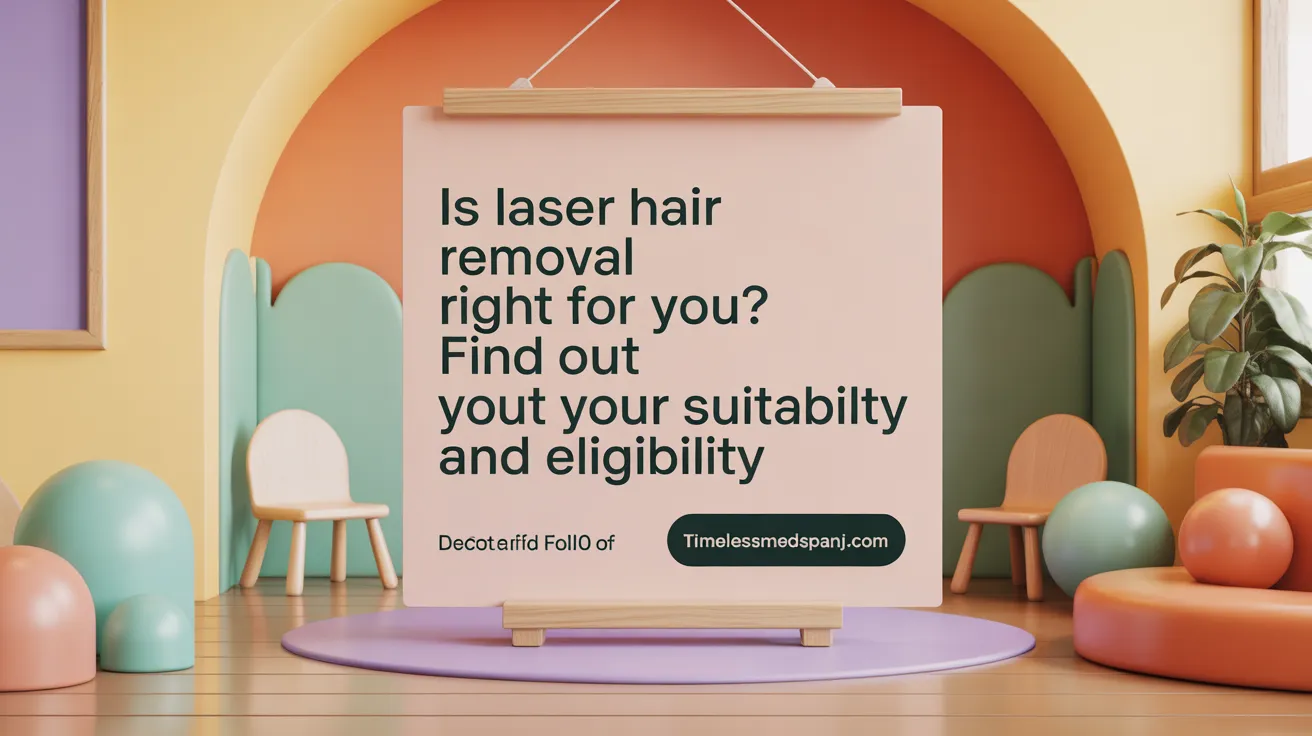Introduction to Laser Hair Removal
Laser hair removal is a revolutionary cosmetic treatment designed to reduce unwanted hair permanently. This guide explores what laser hair removal is, how it works, and what you can expect before, during, and after your treatment sessions. Whether you're researching for personal use or considering starting your hair removal journey, this article covers all essential aspects to help you make an informed decision and achieve the best results safely.
Understanding Laser Hair Removal: How It Works

What is laser hair removal and how does it work?
Laser hair removal is a popular cosmetic procedure that uses concentrated beams of light known as lasers to eliminate unwanted hair. The laser targets the pigment, or melanin, in hair follicles. When the laser is applied, the light energy is absorbed by the melanin, converting into heat that damages the follicle.
This process, based on the principle of selective photothermolysis, allows for precise targeting of dark, coarse hairs while minimizing impact on surrounding skin. The heat generated damages the hair follicle, which inhibits or delays future hair growth.
Since hair grows in cycles, not all follicles are in the growth phase simultaneously, so multiple sessions are needed. The procedure is typically performed with protective eyewear and cooling devices to ensure safety and comfort.
During treatment, patients may feel a quick snapping sensation or a similar prickly feeling. Post-treatment effects may include redness or swelling, which usually subside within hours.
While generally safe when performed by trained professionals, potential risks include changes in skin pigmentation, burns, or scarring. Proper technique and aftercare help optimize results and minimize side effects.
In summary, laser hair removal effectively reduces hair growth by using light energy to destroy hair follicles selectively, making it one of the most efficient long-term hair removal methods.
The Laser Hair Removal Process: What to Expect

Initial consultation and assessment
The process of laser hair removal begins with a consultation with a qualified professional, such as a licensed esthetician or dermatologist. During this session, your skin type, hair color, and medical history are evaluated to determine if you are a suitable candidate. The technician will develop a personalized treatment plan, discussing the number of sessions needed, areas to be treated, and expected results.
Preparation steps before sessions
Proper preparation is crucial for safe and effective treatment. Patients are advised to avoid sun exposure, tanning beds, or tanning products for at least 4-6 weeks prior to the session to prevent skin pigmentation issues. Shaving the treatment area 24-48 hours before the appointment is recommended to remove excess hair and expose hair follicles. It’s also important to avoid waxing, plucking, or threading for at least four weeks, as these methods remove hair from beneath the skin, reducing laser effectiveness.
The treatment session procedure
On the day of treatment, the skin should be clean and free of lotions, deodorants, or other products. A medical professional will often apply a cooling gel to protect the skin and enhance laser efficacy. The target area is then exposed to laser pulses, which emit concentrated light absorbed by the melanin in hair follicles. You may feel a sensation similar to a rubber band snapping against the skin. The technician will pass the laser over the area in a stamping or sweeping motion, depending on the size of the area.
Use of protective eyewear and cooling methods
Protective eyewear is mandatory during the procedure to shield your eyes from the laser light. Many modern laser devices are equipped with cooling systems or cryogen sprays that minimize discomfort and protect the skin from heat. These cooling methods help make the treatment more comfortable and reduce the risk of side effects.
Number and frequency of sessions required
Multiple sessions are usually necessary to achieve optimal results. Typically, six to eight treatments are recommended, spaced approximately four to eight weeks apart. Hair grows in cycles, and lasers are most effective on hairs in the active growth phase. Repeated treatments target these hairs, gradually reducing hair growth across treated areas.
Immediate after-effects and recovery
Post-treatment, you might notice redness, swelling, or a mild tingling sensation, which generally resolve within hours to days. Applying soothing creams and avoiding sun exposure are recommended to aid recovery. It’s important to follow your provider’s post-care instructions, including protecting the skin from UV rays by using sunscreen and avoiding hot showers, strenuous exercise, or irritants in the days following treatment. Over the subsequent weeks, treated hairs will shed, revealing smoother skin and reduced hair growth.
Who Can Benefit? Suitability and Eligibility for Treatment

Who is suitable and eligible for laser hair removal?
Laser hair removal is most effective for individuals with light skin tones and darker, coarse hair because the laser targets the melanin pigment in the hair follicles. People with these characteristics generally see the best results because the contrast between hair and skin allows the laser to precisely focus on hair follicles.
However, advances in laser technology, such as Nd:YAG lasers, enable safe and effective treatment for darker skin tones as well. These specialized lasers are designed to minimize pigmentation concerns in darker skin, broadening the range of candidates.
When it comes to lighter or finer hair, the results may be less noticeable. Laser treatment relies heavily on the presence of melanin; therefore, very light or blonde, gray, or white hair may not absorb enough laser energy to be effectively damaged.
Regarding specific populations, pregnant or nursing women are generally advised to postpone laser procedures as a precaution. Hormonal changes during pregnancy can affect hair growth, and safety data for laser hair removal during pregnancy are limited. It is also important to avoid treatments near the eyes to prevent potential injury.
In all cases, a professional consultation is crucial. During the assessment, the technician or doctor evaluates skin type, hair characteristics, medical history, and expectations. This helps determine if you’re a suitable candidate and develops a personalized treatment plan.
| Aspect | Description | Additional Details |
|---|---|---|
| Skin Types | Light to medium and darker skin tones | Special lasers like Nd:YAG suitable for dark skin |
| Hair Types | Dark, coarse hair preferred | Fine, light hair may have limited results |
| Considerations | Pregnancy, skin conditions, medication use | Consultation ensures safety and effectiveness |
| Areas Commonly Treated | Face, legs, bikini line, underarms, back | Suitable for large and small areas |
Ultimately, meeting with a qualified professional provides clarity on individual eligibility, ensuring a safe and effective treatment experience.
Preparing for Your Laser Hair Removal Session
Before your laser hair removal appointment, proper preparation can significantly improve safety and results. Start with a detailed consultation with a qualified professional, such as a dermatologist or licensed aesthetician experienced in laser treatments. During this visit, disclose your medical history and any medications, especially those that increase skin sensitivity or affect healing.
A crucial step is avoiding sun exposure and tanning activities for at least two weeks prior to your treatment. Tanned skin can increase the risk of side effects like pigmentation changes. If you need to be outdoors, apply a broad-spectrum SPF 30+ sunscreen and wear protective clothing.
You should also abstain from hair removal methods like waxing, plucking, or electrolysis for four to six weeks before treatment. These procedures can damage or remove hair follicles, which are necessary targets for the laser. Instead, shaving the treatment area within 24 to 48 hours before your appointment is recommended. Shaving leaves the hair in the follicle, allowing the laser to effectively target the root while minimizing skin irritation.
On the day of the procedure, ensure the area is clean and free of any products such as lotions, deodorants, or creams. Shower thoroughly and remove makeup if applicable. Wearing loose, comfortable clothing is advised to avoid any unnecessary irritation to the treated area.
Following these preparation steps helps optimize the effectiveness of the laser treatment while reducing the likelihood of side effects. Remember that consistency in pre-treatment care is essential for achieving the best possible long-term results.
Expected Results: Outcomes and Timeline
 Laser hair removal offers a reliable solution for reducing unwanted hair, and most patients notice a significant change within a few months. After completing about six treatment sessions, spaced six to eight weeks apart, individuals typically see a marked decrease in hair growth. The remaining hair tends to be finer and lighter, making it less noticeable.
Laser hair removal offers a reliable solution for reducing unwanted hair, and most patients notice a significant change within a few months. After completing about six treatment sessions, spaced six to eight weeks apart, individuals typically see a marked decrease in hair growth. The remaining hair tends to be finer and lighter, making it less noticeable.
The timeline for results varies depending on the growth cycle of hair, but many see substantial improvements within three to six months after treatment begins. Some hair may regrow over time, but it is usually lighter, thinner, and less prominent than before.
Long-term maintenance requires periodic touch-up sessions, especially for hormonal areas or if new hair appears due to factors like aging or hormonal changes. The overall effectiveness of laser hair removal depends on contrast—patients with light skin and dark hair usually achieve the best outcomes.
While the procedure significantly reduces hair growth, it’s important to have realistic expectations. It does not guarantee complete and permanent removal, and some regrowth might occur, requiring additional treatments. With proper maintenance, the results can last several years, making laser hair removal a popular choice for those seeking a long-term reduction in unwanted hair.
Ensuring Safety and Minimizing Side Effects

What are the safety considerations and potential side effects of laser hair removal?
Laser hair removal is considered a safe cosmetic treatment when performed by trained and experienced professionals. The most common immediate side effects are minor and temporary, including redness, swelling, skin irritation, and slight discomfort. These symptoms typically subside within hours to a few days after treatment.
Some patients may experience changes in skin pigmentation, such as lightening or darkening of the treated area, especially if they have darker skin tones or have recently been exposed to excessive sun or tanning beds. In rare cases, more serious risks like burns, blistering, scarring, or permanent discoloration can occur if proper precautions are not followed.
The choice of laser technology influences safety; for example, Alexandrite lasers are generally used for lighter skin, while Nd:YAG lasers are suited for darker skin tones, reducing risk. Proper device calibration, precise technique, and adequate eye protection are critical factors in safety.
Patient adherence to pre- and post-treatment care significantly minimizes complications. This includes avoiding sun exposure, tanning products, waxing, plucking, and certain skincare products before and after sessions. Following all guidelines ensures the process remains safe, effective, and minimizes side effects.
Overall, when performed by qualified clinicians with appropriate technology and adherence to safety protocols, laser hair removal provides a safe long-term hair reduction solution with minimal risks.
Aftercare and Maintaining Your Results
How should I care for my skin after laser hair removal treatment?
Post-treatment skin care is essential for maximizing results and minimizing side effects. Immediately after the procedure, keep the treated area clean by gently washing it with mild soap and water. Applying a soothing, fragrance-free moisturizer can help reduce dryness and irritation.
Protection from the sun is critical; always use a broad-spectrum SPF 30 or higher sunscreen when exposed to sunlight for at least two weeks. This prevents pigmentation changes and preserves skin tone. Wearing loose, breathable clothing helps reduce friction and irritation around the treated area.
Cooling measures can alleviate discomfort; applying cool compresses or ice packs wrapped in a soft cloth can reduce pain, swelling, or redness. Avoid hot baths, saunas, steam rooms, and vigorous exercise for at least 48 hours after treatment, as heat can exacerbate irritation.
During this initial recovery phase, avoid using harsh or perfumed skincare products, exfoliants, perfumes, or topical irritants that could inflame the skin. Refrain from waxing, plucking, or bleaching hair between sessions, as these methods interfere with the laser’s effectiveness.
If you experience severe side effects like blisters, burns, or persistent swelling or redness, it’s important to seek medical advice promptly. Proper aftercare helps ensure your skin heals well and produces optimal, long-lasting results.
Wrapping Up Your Laser Hair Removal Journey
Laser hair removal is a safe, effective, and popular option for long-term hair reduction when performed by knowledgeable and qualified professionals. Understanding the process, preparing correctly, and following proper aftercare are key to achieving the best outcomes. While not always permanent, the significant reduction in unwanted hair can improve grooming routines and confidence. By dispelling common myths and addressing safety concerns, this guide aims to empower beginners with accurate information to make informed decisions and embark on their laser hair removal treatment with realistic expectations and readiness.
References
- A Beginner's Guide to Laser Hair Removal - Healthy Complexions Spa
- A Beginner's Guide to Laser Hair Removal - Boston Medical Aesthetics
- Laser Hair Removal: The Ultimate Guide For Beginners
- Beginner's Guide to Laser Hair Removal: Benefits, Risks, and Tips
- Laser Hair Removal 101 Guide | Ideal Image
- A Beginner's Guide to Laser Hair Removal: What to Expect - Skin Loft
- 7 Beginner Tips to Prepare for Your Laser Hair Removal Session
